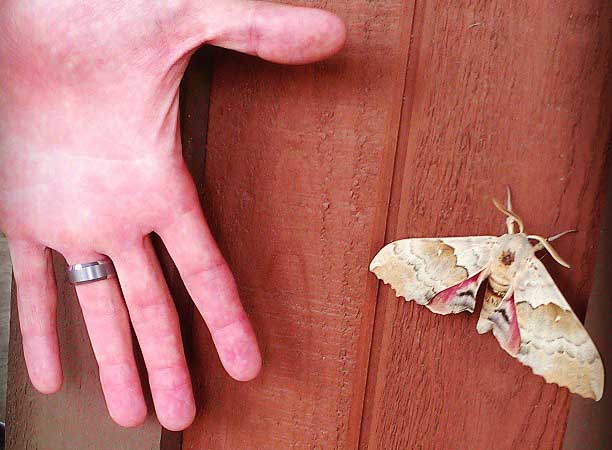Sphinginae subfamily
Sphingini tribe:
 |
Agrius cingulata
BAMONA, the Pink-spotted Hawk Moth
This species has been reported in Utah County,
but would be there only as a stray.
The moth is a very strong flier and is frequently
encountered far north of its usual range.
|
 |
This large bodied moth flies in tobacco fields and vegetable gardens
(potatoes, tomatoes) and wherever host plants are found.
|
 |
This species is not recorded in Utah County, and would be an
unlikely possibility (usually more eastern in Utah).
If you grow tomatoes, however, you have may have encountered it.
Larvae get very large and can strip a tomato plant. |
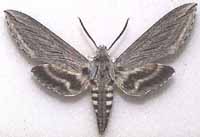 |
This species is not recorded in Utah County, but might be present
(usually more southerly).
It flies in pinyon-juniper woodland and similar arid situations in
Colorado (specimen type locality) and Nevada, Utah,
Arizona and New Mexico. |
 |
Sphinx chersis
BAMONA, the Northern Ash
Sphinx or Great Ash Sphinx
The upperside of the forewing is soft dark-gray to blue-gray with
a series of black dashes, one reaching the wing tip. Note grey
thorax with narrow black lines.
|
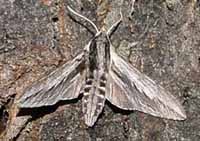 |
It flies in arid brushlands and desert foothills. |
 |
This species is officially reported for Utah County.
I only see them only occasionally on P.E.I. despite visiting lights frequently. |
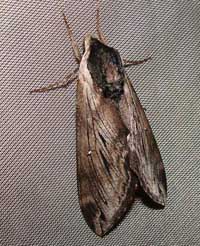 |
This species is confirmed in Weber County by James P. Tuttle, in a disjoint population
from its more common eastern distribution/range.
Note the pm line, absent in Sphinx poecila which flies
more to the north.
The terminal area, especially near the anal angle, is much darker
in Sphinx gordius than
in Sphinx poecila. |
 |
Sphinx luscitiosa
BAMONA,
the Canadian Sphinx or
Clemen's Sphinx
This one is reported from Utah County.
|
 |
Sphinx vashti
BAMONA,, the Snowberry Sphinx,
Snowberry Sphinx adults fly as a single brood in montane woodlands and along prairie
streamcourses from April to August.
The upperside of the forewing has a narrow black subterminal line
bordered by a white inverted V-shaped line on the outside, and a
black line at the apex. |
Smerinthini Tribe:
 |
Pachysphinx modesta
BAMONA,,
the Modest Sphinx or Poplar Sphinx,
This large poplar/willow feeder is possibly in Weber County.
They are a heavy bodied species.
|
 |
This one is quite similar to Pachysphinx modesta, with modesta
being smaller and darker.
Moths should be on the wing from June-August.
|
 |
The grey-blue eyespot of the hindwing gives this species its name.
Larvae feed on birches, willows, cherries and oaks.
The outer edge of the forewings is quite scalloped. |
 |
Paonias myops BAMONA,,
the Small-eyed Sphinx
This small species is probably probably present as it
ranges across North America.
The hindwings have a small blue eyespot ringed with black on a yellow background.
|
 |
Smerinthus cerisyi
BAMONA,, the Cerisyi's
Sphinx or One-eyed Sphinx, Larvae feed on poplars and willows.
Flight would be from late May-July as a single brood.
|
Macroglossinae subfamily
Dilophonotini Tribe:
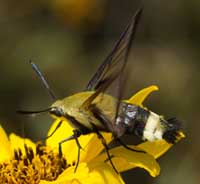 |
Hemaris thetis BAMONA, the Thetis Clearwing
Hemaris thetis is a very variable species, but almost always the abdomen sports contrasting black and
yellow hairs, the ventral surface being quite black. The legs also tend to be quite dark and there is a black mask
running across the eye and along the sides of the thorax.
|
Philampelini Tribe:
 |
This moth is not recorded for Utah County,
but it might be present wherever grapes are found.
Fight would be from June to August. Larvae feed on grape foliage. |
Macroglossini Tribe:
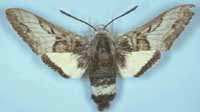 |
Euproserpinus wiesti
WO very doubtful; more southerly,
Wiest's Primrose Sphinx
Euproserpinus wiesti adults fly, during the day, over sand washes
and prairie
blow-outs as a single brood from May-June.
|
 |
Hyles lineata
BAMONA,
the White-lined Sphinx
Adults usually fly at dusk, during the night, at dawn, and during the
day. Moths nectar at salvia and oviposit on a number of different
plants.
|
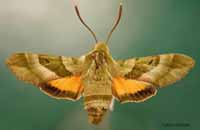 |
Adults fly in the afternoon from April-June in oak woodland and
pine-oak woodland in foothills, nectaring from chia, heartleaf
milkweed, golden currant, bluedicks, fairyfans, vetches,
thistles, hedgenettles, etc. |
|
|
